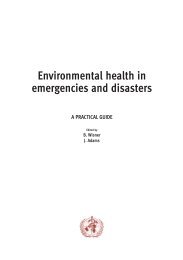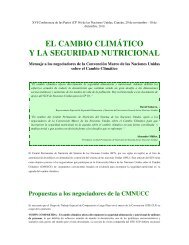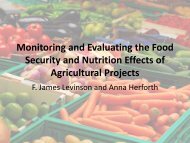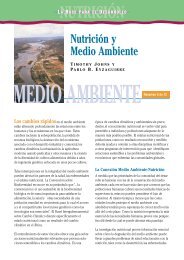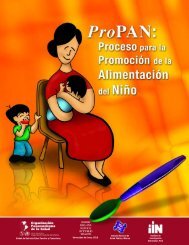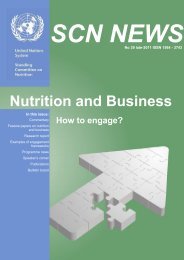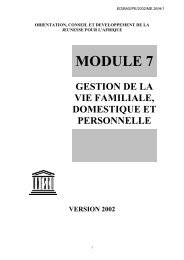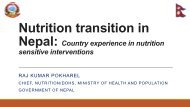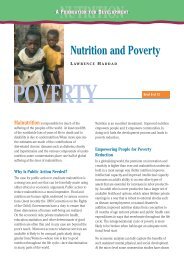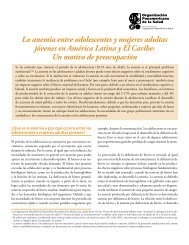SCN News No 36 - UNSCN
SCN News No 36 - UNSCN
SCN News No 36 - UNSCN
Create successful ePaper yourself
Turn your PDF publications into a flip-book with our unique Google optimized e-Paper software.
70<br />
PROGRAMME NEWS<br />
www.unsystem.org/scn<br />
reproductive, newborn and child health, and strengthening use of data to guide implementation;<br />
• Address inequities in coverage of care among different geographic, socioeconomic, age and gender groups;<br />
• Hold governments, financing institutions and international organizations accountable for making adequate resources<br />
available to achieve MDGs 4 and 5, and other health-related MDGs;<br />
• Ensure predictable, long-term financing for reproductive, maternal, newborn and child health which reflects countries'<br />
priorities and plans."<br />
Read the full statement in English (Statement of commitment) or in French (Déclaration d'engagement)<br />
Contact: The secretariat: Countdown to 2015 c/o The Partnership for Maternal, Newborn and Child Health EMail: secretariat@countdown2015mnch.org,<br />
Website: www.countdown2015mnch.org<br />
WHO<br />
Revised indicators for assessing Infant and Young Child Feeding practices<br />
The revised IYCF indicators are the product of a multi-agency collaboration, including WHO, IFPRI, UC Davis, USAID,<br />
FANTA and UNICEF. They were developed in response to a recommendation for new and improved indicators for<br />
assessing feeding in children 6-23 months of age, made by participants in the WHO consultation on complementary<br />
feeding, 2001 (1). The indicators are based on feeding recommendations presented in two documents: the Guiding<br />
Principles for complementary feeding of the breastfed child and the Guiding Principles for feeding non-breastfed children<br />
6-24 months of age (2,3). The indicators are a result of analyses of ten data sets, representing breastfed and nonbreastfed<br />
children in various countries and regions. The main research questions were:<br />
• How well can indicators of dietary diversity or sentinel food groups predict dietary quality for infants and young<br />
children in different populations with varying dietary patterns?<br />
• How well does the frequency of feeding of foods and nutritive liquids other than breast milk predict energy intake -<br />
from foods alone or total - in different populations with varying dietary patterns?<br />
The conclusions of this work are reported in two documents available on the FANTA website (4,5). In addition to<br />
identifying new indicators for assessing infant and young child feeding, working group members also reviewed and<br />
updated existing indicators for assessing breastfeeding practices. Consensus on the indicators was reached in a<br />
meeting held at the WHO Regional Office for the Americas, 6-8 <strong>No</strong>vember 2007. New and revised recommended<br />
indicators for assessing IYCF practices are:<br />
Recommended core indicators<br />
1. Early initiation of breastfeeding: proportion of children born in the last 24 months who were put to the breast within one hour<br />
of birth<br />
2. Exclusive breastfeeding under 6 months: proportion of children 0 – 5 months of age who are fed exclusively with breastmilk<br />
3. Continued breastfeeding at 1 year: Proportion of children 12 – 15 months of age who are fed breastmilk<br />
4. Introduction of solid, semi-solid or soft foods: Proportion of children 6-8 months of age who receive solid, semi-solid or soft foods<br />
5. Minimum dietary diversity: Proportion of children 6-23 months of age who receive foods from 4 or more food groups<br />
6. Minimum meal frequency: Proportion of breastfed and non-breastfed children 6-23 months of age who receive solid, semisolid,<br />
or soft foods (but also milk feeds for non-breastfed children) the minimum number of times or more<br />
• 2 times for breastfed infants 6-8 months<br />
• 3 times for breastfed infants 9-23 months<br />
• 4 times for non-breastfed children 6-23 months<br />
7. Minimum acceptable diet: Proportion of children 6-23 months of age who receive a minimum acceptable diet (apart from<br />
breastmilk)<br />
• Breastfed children who had at least minimum dietary diversity and minimum meal frequency<br />
• <strong>No</strong>n-breastfed children who received at least 2 milk feedings and had minimum dietary diversity and minimum meal<br />
frequency<br />
8. Consumption of iron-rich or iron-fortified foods: Proportion of children 6-23 months of age who receive an iron-rich food or<br />
an iron fortified food that is specially designed for infants and young children, or that is fortified at home<br />
Recommended optional indicators<br />
1. Children ever breastfed<br />
2. Continued breastfeeding at 2 years<br />
3. Age-appropriate breastfeeding<br />
4. Predominant breastfeeding under 6 months<br />
5. Duration of breastfeeding<br />
6. Bottle feeding<br />
7. Milk feeding for non-breastfed children<br />
<strong>SCN</strong> NEWS # <strong>36</strong> back to contents




